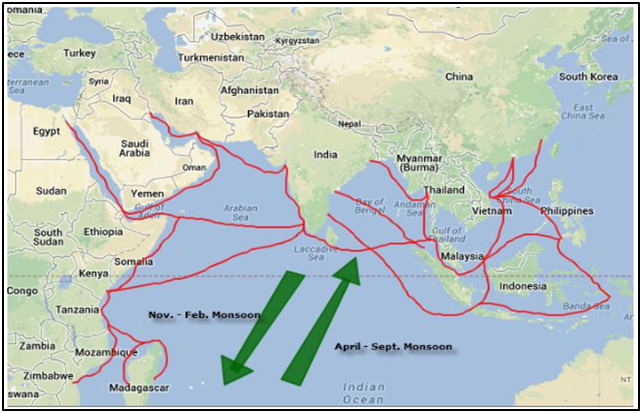Why in News?
- In another move among the series of steps taken by the government to reclaim India’s long-lost heritage in different sectors, the Centre now plans to revive the ancient maritime heritage.
- The Ministry of Culture has recently joined hands with the Indian Navy and Goa-based Hodi Innovations to reconstruct an ancient stitched ship - that traversed India's ancient maritime trade routes around 2,000 years ago.
What’s in Today’s Article?
- Ancient Maritime Trade Routes on the Indian Ocean
- What is the ‘Stitched Ship’ Technique?
- About the Project to Reconstruct an Ancient ‘Stitched Ship’
- The Voyage and its Significance
- What is Project Mausam?
Ancient Maritime Trade Routes on the Indian Ocean:

- According to the Archaeological Survey of India (ASI), naval trade on the Indian Ocean dates back to the 3rd century BC.
- During this time, residents of the Indus Valley opened maritime trading with Mesopotamia, Egypt, East Africa, and the Roman Empire.
- Through these maritime trade networks, many goods were exchanged, including medicine, aromatics, spices, wood, grain, gems, textiles, metal and stones.
- The trade, in turn, facilitated the exchange of religions, cultures and technologies, contributing to the expansion of Buddhism, Christianity and Hinduism.
What is the ‘Stitched Ship’ Technique?
- This age-old technique involves shaping the wooden planks using the traditional steaming method to conform to the shape of the hull.
- Each plank will then be stitched to another using cords/ ropes, sealed with a combination of coconut fibre, resin, and fish oil - similar to the ancient Indian shipbuilding practice.
- The ancient stitching technique almost became extinct after the Britishers came to India, where the wooden planks were attached to support the recoil of canons.
- Sewn boat construction techniques were used prior to the development of metal fasteners, and continued to be used for small boats to reduce construction costs where metal fasteners were too expensive.
About the Project to Reconstruct an Ancient ‘Stitched Ship’:
- The project was approved by the National Implementation Committee, chaired by the Union Home Minister, in (December) 2022.
- While the Indian Navy is overseeing the ship’s design and construction and would also be sailing the ship along ancient maritime trade routes, the Ministry of Culture has fully funded the project.
- The project is set to cost Rs 9 crore and is expected to take around 22 months to complete and will be in synergy with the Ministry of Culture’s Project Mausam.
- The ministries of Shipping and External Affairs will be supporting the project in its execution stage.
- The stitching work will be undertaken by a team of traditional shipwrights led by Babu Sankaran, considered an expert in the stitched ship technique.
The Voyage and its Significance:
- Once the ship is ready, the voyage with a seam of 13 Indian Navy crew from Odisha’s Cuttack will be sent to Bali in Indonesia, in (November) 2025.
- The navigation techniques used for the voyage will also be in consonance with old times, also aiming to show the sophistication India had achieved in this field at the time.
- The voyage will be a part of the initiative to revive and honour India’s old maritime trade routes.
- This is also in line with the larger decolonisation project undertaken, in the run-up to 2047, when independent India turns 100.
What is Project Mausam?
- Launched in 2014 (at the 38th World Heritage Session at Doha), Project Mausam is led by the Ministry of Culture and implemented by the Indira Gandhi National Centre for the Arts (IGNCA), New Delhi.
- Project Mausam aims -
- To reconnect and re-establish maritime cultural connections with the 39 countries bordering the Indian Ocean.
- To create an understanding of cultural values and concerns.
- Project Mausam is said to be India’s answer to the Maritime Silk Road of China, and India plans to move UNESCO to award transnational heritage status to Project Mausam.
- Several countries including the UAE, Qatar, Iran, Myanmar, and Vietnam have expressed great interest in this multifaceted cultural project.









